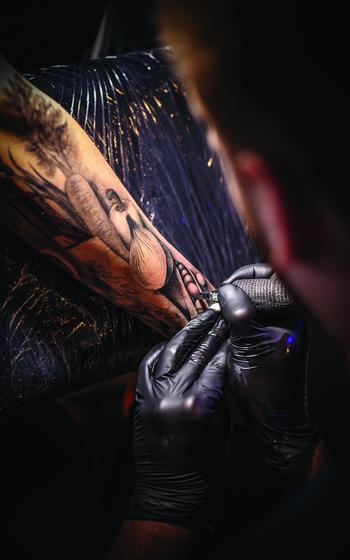
(Photo by Brittany Atkins)
Many workplaces, including the military, are lessening the restrictions on visible tattoos.
Tattoos used to be heavily viewed with skepticism and judgment. However, with each passing year, more and more people are getting tattooed as the stereotypes fade and the stigmas disappear. Nonetheless, there is still some outdated and overall incorrect information floating around. Here is some information to help set the record straight about tattoo stereotypes and stigmas.

(Photo by Brittany Atkins)
1. Tattoo Shops are Scary and Unhygienic
Tattoo parlors are no longer the seedy shops in the underbelly of town. In fact, once the U.S. started reopening in 2021, tattoo parlors were booked far out because tattooing is a very hygienic process with its use of masks, gloves, sterile products, etc. Tattoo parlors and tattoo artists in the U.S. are required to follow certain Occupational Safety and Health Administration (OSHA) and CDC rules. In many Asian countries, tattoo artists are required to have a medical license. Germany has the Deutsche Organisierte Tätowierer, or German Association of Professional Tattoo Artists, whose aim is to “to maintain and even increase the quality and performance standard in the area of tattooing and studio hygiene.”
2. Getting a Tattoo is Not Safe or Sanitary
While getting a tattoo is not risk-free, one must research the parlor and artist before committing; the process of getting tattooed is almost equivalent to a medical procedure. The artist creates a stencil for the piece you have discussed. Before the stencil touches your skin, the artist cleans the area. The artist will then use a special type of paper to transfer the stencil to your skin (almost like the temporary tattoos you got as a kid). The artist then uses a variety of needles to tattoo you, like liners and magnums, just to name a few. Depending on the type of tattoo you are getting or even what part of the tattoo the artist is at, the needle will puncture the skin 50 to 3,000 times a minute according to creativeinktattoo.com.
3. Getting Tattooed is an Extremely Painful Process
There is really no way to “prove” or “disprove” this. It really all depends on the person as well as the placement of the tattoo. Pain levels can range from mildly irksome or annoying to intolerable. Typically, the least painful places to get tattooed can be the outer arms, forearms, calves, shoulders and top of the thigh. The most painful places can be the armpits, head, neck, elbow, knee, stomach and ribcage.
4. Only “Certain” Types of People Can Get Tattoos
Gone are the days of only sailors, bikers and spring-breakers in Cabo getting inked. Tattoos have evolved into a new form of art and self-expression for all types of people. Unfortunately, that does not mean that tattooed people are not being stigmatized and discriminated against. Children’s public tantrums are sometimes blamed on parents’ wayward morals of having tattoos rather than the fact that children throw tantrums sometimes. Many employers require that tattoos are not visible. Although, many more workplaces, including the military, are lessening the restrictions on visible tattoos. Tattoos do not make a person any better or worse of a human being; just a human being that decided to be permanently colored on.
5 .All Tattoos Have A “Deep Meaning”
This is really a personal choice. Of course, something that is being tattooed on your body should have some thought put into it. Nonetheless, it is your body and if you want to tattoo it, you do not have to justify that to anyone with a ten-minute diatribe about the significance of the infinity symbol on your calf.
6. You Will Regret It When You’re Older
This is impossible to predict. You may regret a tattoo when you get older. But this will most likely have to do with getting a “Khaleesi” tattoo before watching the eighth season of “Game of Thrones” more so than regretting the actual process of being tattooed. The chances that you will wholeheartedly regret the tattoo is much lower than others may have you believe, if you do …
7. Tattoos are Forever
This is probably the most truthful of the stereotypes because the very permanency of tattoos is the point of their existence. Yet, if you want one gone, you have options. There is always the option of covering it up. Cover-up tattooing styles have advanced so much that most times you cannot even tell the rose on your bicep used to say “Lucy.” There is also the option of getting laser tattoo removal, which according to WebMD, “can significantly diminish the appearance of your unwanted tattoo with minimal side effects.” If you tattooed an ex’s name, the wrong Super Bowl winning team or something as a result of a lost bet on your body, you are not stuck with it forever.
Erica Lockuff

(Photo by Brittany Atkins)
“I’m sure a lot of women can relate to the stares you may get having so many tattoos. I’ve gotten used to it but there is definitely still a stigma behind tattoos and women getting tattoos in my opinion. I’ve been asked by parents in front of their kids to say I regret my tattoos as a way to discourage their kids from getting them in the future, but my parents were always supportive of me and my art styles and tattoos are just another medium of art and nothing to be ashamed of!”
Tiffany Winston

(Photo by Brittany Atkins)
“I believe my tattoos break the stigma associated with my various roles in life. I am a physician and 10 years ago, physicians weren’t flaunting tattoos as openly as they do these days which I still feel isn’t as freely accepted as it should be.”


AloJapan.com